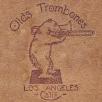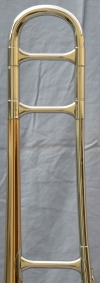
It's a bear!
c. 1939 Olds Feather Weight
Bore: .485”/.500” (12.3 mm/12.7 mm)
Bell: 7” (177.8 mm)
The wide tone ring Super looked awesome, but it was also pretty darn heavy. Olds quickly introduced a solution to that issue in the form of the Feather Weight (sometimes called the "Super Feather Weight"). At the very least, they thinned the handslide brace, reduced the bell diameter by �” (12.7 mm), and shortened up the inner slide stockings (I've heard of Feather Weights with round inners, but this one's are duo-octagonal). I suspect they may have thinned the metal out in some places, too. The Featherweight outer slide weighs just 6 ounces (170 g); by comparison, a “normal” Super outer slide from the same era weighs in at 8 ounces (226 g) and a King “Jiggs” 2B outer slide weighs 6.4 ounces (182 g) . Two ounces doesn’t sound like a big difference, but I expect it would be noticeable at the end of a four-hour dance gig.
Olds apparently did not resume production of the Featherweight after WWII, electing to lighten up the handslide brace on the regular Super instead. For that reason, they are uncommon, if not downright rare.
This horn has a serial number of 117xx (bell and slide), dating it from around 1939; in fact, it's very close to this early narrow tone ring Super.. The matierals are identical to the contemporary Super Olds; a "bronze" bell (actually red brass) with a nickel silver tone ring, with the rest of the instrument being entirely nickel silver. As with Supers of this vintage, the engraving was done by hand.
 Overall View Front |
 Engraving 1 |
 Bell Section Braces |
 Stockings Normal on left, Feather Weight on right |
 Overall View Back |
 Engraving 2 |
||||
 End Crook Detail |